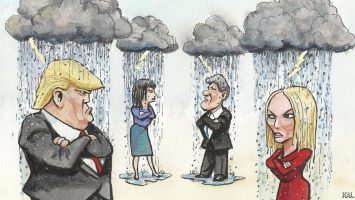
The Federal Reserve made its most forceful stride in almost 30 years on Wednesday, raising its benchmark financing cost by 3/4 of a rate highlight battle increasing expansion.
It additionally pointedly expanded its projections for expansion going ahead, while likewise controling its appraisals of financial development.
For expansion, the national bank currently sees its leaned toward proportion of expansion hitting 5.2% this year from 4.3% in March, albeit the center rate barring food and energy costs is fixed at 4.3%, up just 0.2 places. That would really be a reduction from its rate in May.
GDP is gauge to drop by more than 1 rate point from its March gauge, presently 1.7% rather than 2.8%.
In any case, the Fed kept on portraying an economy sufficiently able to endure its arranged series of rate climbs, which will take the government finances rate at which banks can acquire for the time being to 3.4% – up from 1.9% back in its March “dab plot.”
“Generally speaking financial movement seems to have gotten subsequent to edging down in the main quarter,” the Fed said in its assertion going with the news. “Work gains have been strong as of late, and the joblessness rate has stayed low. Expansion stays raised, reflecting organic market irregular characteristics connected with the pandemic, higher energy costs, and more extensive cost pressures.”
The expansion in rates at last moves through the economy as greater expenses for everything from vehicles to Mastercards. The increment is the biggest beginning around 1994 and is an acknowledgment of how unavoidable expansion it once named “short lived” has become. It was just a month prior that Fed Chairman Jerome Powell discouraged the possibility of a 75 premise point climb.
The Fed had been broadcasting a 50 premise point climb in June for quite a long time, yet Friday’s report that buyer costs had risen more than anticipated – at a yearly pace of 8.6% in May contrasted with 8.3% in April – drove many on Wall Street to call for and anticipate a bigger increment.
Powell refered to the shopper cost record information as well as one more study that proposed expansion assumptions had ascended as the justification behind the bigger than regular climb in the government finances rate at its question and answer session following the declaration. Furthermore, he teed up the possibility of a comparative increment at the Fed’s next gathering in July.
“According to the viewpoint of today, either a 50 premise point or a 75 premise point increment appears to be doubtlessly at our next gathering,” Powell said. “We guess that continuous rate increments will be suitable.”
Prior Wednesday, the Census Bureau detailed that retail deals fell 0.3% in May, flagging that purchasers might be pulling back despite high gas and food costs. While Powell would invite some easing back of interest in the economy, it is a precarious errand to adjust handling runaway expansion without tipping the economy into a downturn.
“The national bank is plainly hurrying to make up for lost time following a flood in expansion that has been a lot bigger and more extensive based than expected,” said James McCann, senior worldwide financial specialist at abrdn. “Seat Powell has hyped up the possibilities of a delicate arriving in development and expansion on the rear of a very quick strategy change. However, history recounts an alternate story.”
“Hard arrivals are undeniably more normal notwithstanding fixing, particularly when the economy is tight and compensation and value expansion are running hot,” McCann adds. “All of which portray current financial circumstances.”
That’s what McCann says “the size of the change in development expected to facilitate these uneven characters will require a downturn in the US later one year from now. “There is as yet a way for a delicate landing, ought to supply chains quickly recuperate, and laborers flood once more into the work market. Yet, a ton needs to go right to take the strain of change off the Fed,” he adds.
An easing back economy in the midst of high customer costs is the last thing the White House needs or needs heading into the midterm decisions. However, sadly for President Joe Biden and the Democrats, that is looking progressively possible.
A large part of the ascent in expansion can be followed to the Russian attack of Ukraine in February and the subsequent spike in energy costs that have resulted and moved through different pieces of the economy, similar to transportation and food. However, it likewise mirrors the outsized improvement that Congress and the Biden organization upheld to manage the financial impacts of the Covid.
Presently, the Fed is on target to turn around the phenomenally accommodative money related approach it has been following for quite a long time. Also, that is probably going to cause more agony before it brings any alleviation.
“The pain free income strategies of the Federal Reserve, especially following the worldwide monetary emergency, have prompted a financialization of the economy,” says Troy Ludtka, U.S. Financial analyst at Natixis CIB Americas.
“The U.S. is turning out to be more delicate to changes in loan costs,” he adds. “The dependence on modest obligation and developing resource values implies the Federal Reserve (and the customary way of thinking) is probably going to misjudge the nonpartisan pace of interest. The Fed will climb forcefully prior to fixing it.”




Leave a Reply